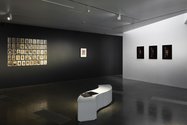John Hurrell – 5 April, 2016
While he is being measured by a female white-coated technician, Ioane /Maui has a defiant glare that counteracts his head width being calculated by a pelvimeter, his nose width and nose length by a vernier caliper, his bicep skin thickness by a skinfold calliper, and upstairs, his height by a stadiometer. On one level it's obviously a none-too-amusing satire on colonial objectification, scientism when applied to some races and not others. On another level it could be an oblique, veiled joke about the putative genital attributes of black men in the minds of lusting white women.
Titirangi
Yuki Kihara
A Study of a Samoan Savage
27 February - 22 May 2016
Presenting a two roomed exhibition at Te Uru, Yuki Kihara has a space on each of two floors, one above the other; A Study of a Samoan Savage is a complicated show that deals with several intricately woven together thematic threads.
The ground floor room looks at three themes: the possibly dubious (racist) aspects of twenties anthropology as found in the handbook of Louis Sullivan published in 1928: the (it might be argued - at times - voyeuristic) photographic investigations of moving male figures by Étienne-Jules Marey and Eadweard Muybridge in the 1870s; and the related painting by Marcel Duchamp, Nude Descending a Staircase, No. 2, 1912.
The upstairs space examines racism in the world of New Zealand rugby in a manner that is highly complex and many sided. A TV presenter talks with the Blues coach and several Polynesian players about abuse from spectators; a burger ad involving such players is featured that presents possibly racist representations of Mexicans and Native Americans; the marketing of brown ‘hunks’ in the media is also looked at. In the same room the Sullivan anthropological theme is continued by looking at nineteenth century documentary photographs from the collections of the Pitt Rivers and British Museums. Quite a wide field of exploration, and with some very clever juxtapositions.
In the ground floor presentation the space is dominated by the imposing presence (through Kihara’s photographs and video) of Samoan artist Ioane Ioane, Kihara’s model. He is here presented as Maui, the shapeshifting trickster demi-god. While he is being measured by a female white-coated technician, Ioane/Maui has a defiant glare that counteracts his head width being calculated by a pelvimeter, his nose width and nose length by a vernier caliper, his bicep skin thickness by a skinfold calliper, and upstairs, his height by a stadiometer. On one level it’s obviously a none-too-amusing satire on colonial objectification, scientism when applied to some races and not others. A selective process of possibly not intended humiliation. On another level it could be an oblique, veiled joke about the putative genital attributes of black men in the minds of lusting white women.
These downstairs photographic images (also on display in Auckland Art Gallery in a show with John Pule) I think are the best thing in the show. The contrast between what we can see of the person measuring and the subject being measured provides powerful drama and understated humour. The other works referencing Duchamp, Marey and Muybridge, although they might seem clumsy and obvious because so many artists have alluded to them already, are interesting because of the issues they raise about nakedness, ethnicity, cultural context and power. One of Ioane kicking a football into the air - while he is running naked - is particularly clever as it draws together the two exhibiting spaces.
Kihara‘s show has a very good (beautifully illustrated) catalogue with an introduction, essays and poems by Andrew Clifford, Mandy Treagus, Fa’anofo Lisaclaire Uperesa, and Momoe Von Reiche - designed by Julia Gamble. The main emphasis of the publication is the group of issues around anthropology and the collecting of statistical data and photographs, rather than say the properties of rugby (its exacerbation of violence) and the power of the mass media.
There’s lots of layering here. A good example is something that Lisa Uperesa points out, that the walking image of Maui resembles the famous March of Progress image of homo sapiens evolving from ape ancestors. This is another dimension other than that of its resemblance to the sequential photographs of Muybridge. It is a wry nod to Darwinism and our own perception of humanness and the verticality of walking, while mocking notions of ethnic superiority and pulling (as a reference) such discussion into the exhibition.
Rich in its different types of foci, this complex show is provocative, stimulating and informative, but surprisingly unpredictable in some of the conclusions you may reach. Some of the sportsmen in the video, for instance, come across as really naïve in their involvement with advertising and issues of racial stereotypes. A fascinating presentation.
John Hurrell






 Advertising in this column
Advertising in this column Two Rooms presents a program of residencies and projects
Two Rooms presents a program of residencies and projects



This Discussion has 0 comments.
Comment
Participate
Register to Participate.
Sign in
Sign in to an existing account.